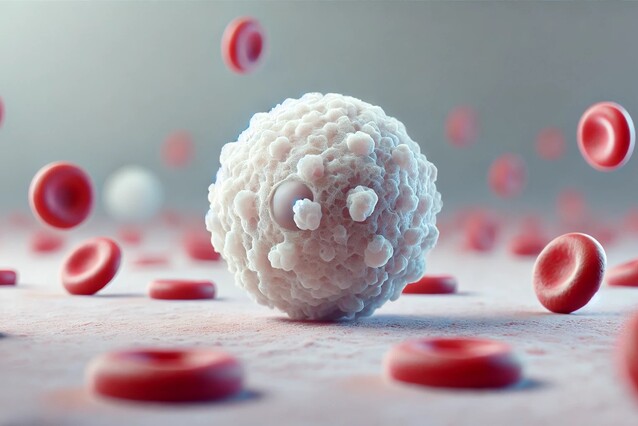Targeted protein breakdown in mice reveals new insights into B-cell development
B-cells are vital white blood cells responsible for producing antibodies to fight off infections in our body. Their development is tightly regulated by several transcription factors that activate the genes needed to guide them through the sequential stages of maturation. The exact role of each transcription factor has remained unclear due to several limitations in current methods, such as gene knockouts, which are constrained by the essentiality of these genes. Researchers from Meinrad Busslinger’s lab now employed a new tool to target protein elimination in live mice and observed how these factors directly influence gene activity. Their findings are published in the journal Nature Immunology.
When our immune system detects a foreign agent, B cells spring into action and produce thousands of antibodies per second to neutralise the threat. Also known as B lymphocytes, this type of white blood cell is integral to our adaptive immune system. They originate in the bone marrow, and their development starts with the process of early B-lymphopoiesis. Early blood cells are guided through several stages: initial differentiation into B cell precursors, commitment to the B cell type, and maturation into fully functional B cells.
This process is orchestrated by multiple transcription factors, which activate the necessary genes at precise time points to ensure the proper development of progenitor cells into mature B cells. This meticulous regulation is essential for producing B cells capable of responding to infections.
To dissect the transcriptional networks that regulate B cell development across different stages, researchers often inactivate genes that encode key transcription factors to observe their effects on the process. However, this approach has drawbacks. It can arrest cell differentiation at abnormal stages, making it difficult to distinguish direct effects from indirect ones, and is often limited by the essentiality of transcription factor genes–when inactivated, cell survival is often compromised, further complicating studies.
To overcome these challenges, scientists from the lab of Meinrad Busslinger used a new technique that allowed them to quickly and transiently eliminate selected proteins in live mice without the undesired effects of traditional methods. By using a system that triggers the precise breakdown of key transcription factors with controlled short timing, the researchers were able to study their function before the generation of confounding developmental defects. This allowed them to observe how these factors directly influence gene activity, revealing new insights into their roles during B cell development. Their findings are now published in the journal Nature Immunology.
Switching off proteins in live mice on demand
The transcriptional control of early B-cell development has been extensively studied in mice using methods such as gene knockout, either throughout the entire organism from birth—germline knockout—or at specific developmental stages. As gene knockout permanently removes a gene from the cell, this can lead to developmental anomalies, which complicates the study of dynamic biological processes and results in secondary effects that obscure direct gene functions.
To address these issues, Busslinger’s team used the auxin-inducible degron 2 (Aid2) system, a powerful tool for targeted and rapid protein degradation. Originally developed for use in living cells, they applied the method to study protein function in live mice.
This system works by attaching a small sequence to a protein of interest–also known as Aid tag. This tagged protein is then able to be recognised by Tir1, a plant-derived E3-ligase-adaptor protein, which facilitates the attachment of ubiquitin molecules to the tag. Ubiquitin then marks the protein for destruction by the proteasome, a cellular waste disposal system.
The advantage of this tool is that the interaction between the Aid tag and Tir1 only occurs in the presence of the plant hormone auxin, a molecule which is not naturally found in mammals but that can be added in by researchers. This addition is what triggers the rapid ubiquitination and destruction of the selected protein. “With this technique we could look into protein function in real-time in live mice. We observed the roles of five transcription factors in B cell development more clearly than ever before,” says Tanja Schwickert, postdoc in the Busslinger lab and last author of the paper.
The team followed the contributions of the known transcription factors E2A, Ebf1, Pax5, Ikaros, and Aiolos at different stages of B cell formation. “It was quite surprising to discover that one of them, Ikaros, only acts as a repressor and doesn't activate genes as we used to think,” says Meinrad Busslinger, Emeritus Senior Group Leader at the IMP.
By targeting the elimination of these factors both individually and in combination, the scientists revealed that each regulates distinct sets of genes, and in some cases cooperate to control gene activity in early B cell development.
With the Aid2 system, researchers can transiently eliminate proteins in cells, and now in whole organisms, rapidly or for extended periods. The method can provide many new insights into the gene regulation of complex networks in various biological contexts, and Busslinger expects it to become widely adopted in research for its versatility and precision. “This project was an enormous teamwork, and it paves the way for future advancements in both basic and medical research,” concludes Busslinger.
Original publication
Anna S. Fedl*, Hiromi Tagoh*, Sarah Gruenbacher*, Qiong Sun, Robyn L. Schenk, Kimon Froussios, Markus Jaritz, Meinrad Busslinger# & Tanja A. Schwickert# “Transcriptional function of E2A, Ebf1, Pax5, Ikaros and Aiolos analyzed by in vivo acute protein degradation in early B cell development.” Nature Immunology (2024). DOI: 10.1038/s41590-024-01933-7
*These authors contributed equally. #Corresponding authors.
Further reading
